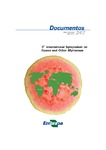Por favor, use este identificador para citar o enlazar este ítem:
http://www.alice.cnptia.embrapa.br/alice/handle/doc/923213Registro completo de metadatos
| Campo DC | Valor | Lengua/Idioma |
|---|---|---|
| dc.contributor.author | CASTRO, J. M. da C. e | pt_BR |
| dc.contributor.author | SANTOS, C. A. F. | pt_BR |
| dc.contributor.author | FLORI, J. E. | pt_BR |
| dc.date.accessioned | 2012-04-26T11:11:11Z | pt_BR |
| dc.date.accessioned | 2012-04-26T11:11:11Z | pt_BR |
| dc.date.available | 2012-04-26T11:11:11Z | pt_BR |
| dc.date.available | 2012-04-26T11:11:11Z | pt_BR |
| dc.date.created | 2012-04-26 | pt_BR |
| dc.date.issued | 2012 | pt_BR |
| dc.identifier.citation | In: INTERNATIONAL SYMPOSIUM ON GUAVA AND OTHER MYRTACEAE, 3., 2012, Petrolina. Abstracts... Petrolina: Embrapa Semiárido, 2012. | pt_BR |
| dc.identifier.uri | http://www.alice.cnptia.embrapa.br/alice/handle/doc/923213 | pt_BR |
| dc.description | Brazil was the 7th world guava producer in 2008, producing 298,798 ton in 15,641 ha. However, the presence of the root-knot nematode, Meloidogyne enterolobii, has been caused severe loss to guava growers. From 2001 to 2008 it was estimated a direct economical loss of around 70 million dollars and 3,703 unemployment of workers in five Brazilian States, due the attack of this pest. Based on this, it was evaluated 146 Psidium accessions, guava and araçazeiros from ten Brazilian States, in greenhouse and nursery conditions in order to find out resistant accessions to be used as rootstock of commercial guava cultivars. At greenhouse, plants with 15 to 20 cm height were inoculated with 10,000 nematode eggs, in an experimental incomplete block design, with five to ten replications. Under field nursery conditions, after seed germination, the plants were transferred to plastic bags with nematode contaminated soil. After five months of inoculation, the greenhouse accessions were evaluated for nematode damage according to presence of root gall or egg mass scale: 0 = no root galls or egg masses, 1 = 1-2, 2 = 3-10, 3 = 11-30, 4 = 31-100, and 5 = more than 100 root galls or egg masses. A reproductive factor (RF) was estimated and the accessions classified as resistant or susceptible. The plants grown at field nursery were visually evaluated for the presence of root galls after five months of transplanting to plastic bag. A total of sixty-six Psidium, including fourteen araçazeiro and fifty-two guava accessions, were evaluated at field nursery conditions. Among the araçazeiros, two were classified as resistant, and another presented segregation to the tolerance to nematode. All guava accessions were susceptible in both evaluation conditions. Among the nineteen araçazeiro accessions evaluated in greenhouse, three were resistant to the nematode (RF < 1) and nine were immune (FR = 0). A further investigation performed among some tolerant araçazeiros accessions collected in the Brazilian sub tropical region (South), it was observed a poor plant development in the semiarid region of Northeast Brazil and low grafting compatibility with commercial guava cultivars. The current strategy to overcome this guava pest include the development of inter specific Psidium hybrids among olerant araçazeiros and susceptible guava in order to obtain hybrids with adequate plant height and stem diameter, highly compatible when used as rootstock of commercial guava cultivars. | eng |
| dc.language.iso | eng | eng |
| dc.relation.ispartofseries | (Embrapa Semiárido. Documentos, 247). | pt_BR |
| dc.rights | openAccess | eng |
| dc.subject | Meloidogyne enterolobii | pt_BR |
| dc.subject | Enxertia | pt_BR |
| dc.subject | Acesso | pt_BR |
| dc.subject | Nematoide das galhas | eng |
| dc.title | Reaction of Psidium accessions to the nematode Meloidogyne enterolobii. | pt_BR |
| dc.type | Resumo em anais e proceedings | pt_BR |
| dc.date.updated | 2012-04-26T11:11:11Z | pt_BR |
| dc.subject.thesagro | Goiaba | pt_BR |
| dc.subject.thesagro | Nematóide | pt_BR |
| dc.subject.thesagro | Araçá | eng |
| dc.subject.nalthesaurus | Guavas | eng |
| dc.format.extent2 | p. 36. | pt_BR |
| riaa.ainfo.id | 923213 | pt_BR |
| riaa.ainfo.lastupdate | 2012-04-26 | pt_BR |
| dc.contributor.institution | JOSE MAURO DA CUNHA E CASTRO, CPATSA; CARLOS ANTONIO FERNANDES SANTOS, CPATSA; JOSE EGIDIO FLORI, CPATSA. | pt_BR |
| Aparece en las colecciones: | Resumo em anais de congresso (CPATSA)  | |
Ficheros en este ítem:
| Fichero | Descripción | Tamaño | Formato | |
|---|---|---|---|---|
| CArlosAntonio2012.pdf | 793,03 kB | Adobe PDF |  Visualizar/Abrir |









